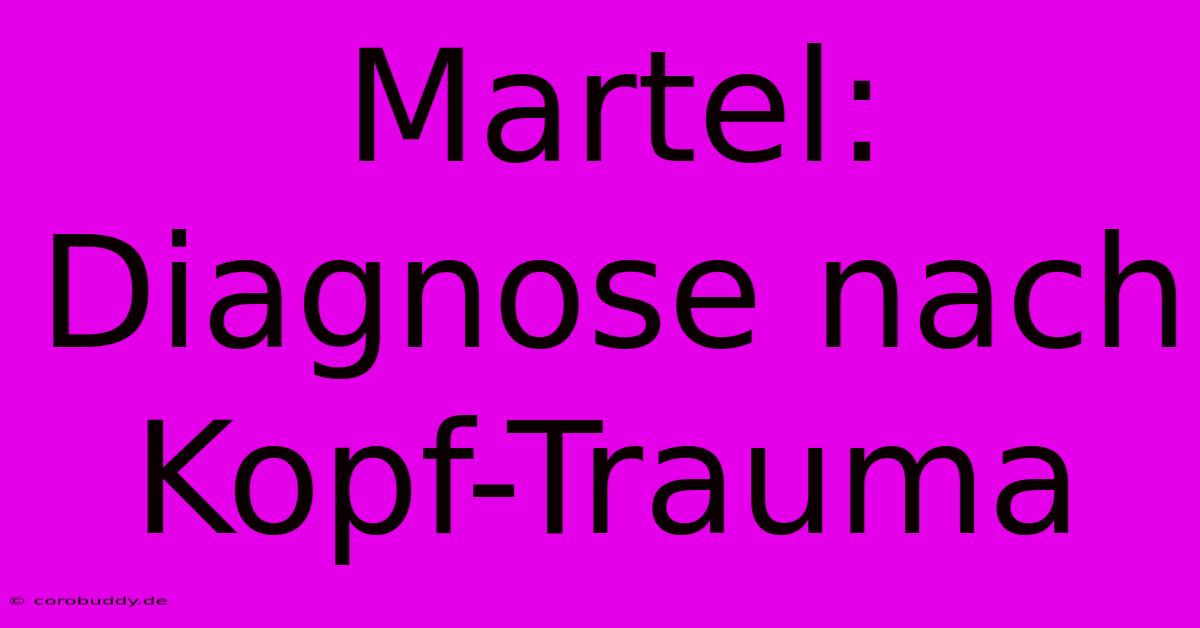Martel: Diagnose Nach Kopf-Trauma

Discover more detailed and exciting information on our website. Click the link below to start your adventure: Visit Best Website Martel: Diagnose Nach Kopf-Trauma. Don't miss out!
Table of Contents
Martel: Diagnose nach Kopf-Trauma
Hey Leute, let's talk about something serious: Martel's classification after a head injury. This isn't something I wish on anyone, but since I've spent a chunk of my career working with trauma patients, I've seen firsthand how important a solid diagnosis is – and how easily things can go wrong.
I'll never forget this one case. A young cyclist, maybe 20, came in after a nasty fall. Initially, everyone thought it was just a concussion, you know, the usual bumps and bruises. But, we missed something crucial: the subtle signs of a Martel fracture. It wasn't immediately apparent on the initial X-rays – those sneaky little fractures can be tricky! We almost sent him home. Luckily, a more experienced colleague caught it later. That was a close call, and a harsh lesson in careful observation.
Understanding Martel Fractures
So, what exactly is a Martel fracture? It's a specific type of skull fracture that often occurs after a head trauma. It's characterized by a fracture line that runs through the pterion region – that's the area where the frontal, parietal, temporal, and sphenoid bones meet. Think of it as the "weak point" of the skull. It’s named after a French surgeon, and often involves the middle meningeal artery, which can lead to life-threatening epidural hematomas – basically, a blood clot between the skull and the brain. Serious stuff, people.
The diagnostic process is key. It’s not always straightforward. A good neurological exam is essential, looking for signs like changes in consciousness, pupils, and motor function. But, like I said, sometimes you won’t see much on the initial X-ray. That's why CT scans are so important. They provide a much more detailed view of the skull and brain. Modern CT scanners are amazing; they pick up on so much detail that was previously impossible.
Martel Fracture Classification
Martel fractures themselves are categorized in a couple of ways, usually based on the severity and extent of the fracture. I'm not going to bore you with the technical details, but knowing the type of Martel fracture guides treatment decisions. A neurosurgeon would always be involved, making decisions based on multiple factors, including the fracture type, any associated intracranial hemorrhage and the patients clinical state.
Tips from My Experience:
- Don't rush the diagnosis: Take your time, especially with head trauma cases. Think "slow and steady wins the race".
- Image is key: High-quality imaging, like CT scans, is essential. Don't just rely on X-rays alone.
- Know your anatomy: A strong grasp of skull anatomy is crucial.
- Consult with specialists: Don't be afraid to ask for help from neurosurgeons or other specialists. Teamwork is vital in these cases.
- Stay updated: Head trauma management constantly evolves. Make sure you stay current with the latest research and best practices. This is something you need to stay on top of, as it’s a dynamic field.
Dealing with head injuries is intense and requires a deep understanding of the anatomy and the diagnostic process. You learn so much through experience, and unfortunately, some of that comes from mistakes. Always try to stay on top of the game and never underestimate the power of collaboration.
This information is for educational purposes only and should not be taken as medical advice. Always consult with a healthcare professional for any health concerns or before making any decisions related to your health or treatment.

Thank you for visiting our website wich cover about Martel: Diagnose Nach Kopf-Trauma. We hope the information provided has been useful to you. Feel free to contact us if you have any questions or need further assistance. See you next time and dont miss to bookmark.
Featured Posts
-
Ungewohnter Bvb Freiburg Sieg Fans Staunen
Nov 23, 2024
-
F1 Las Vegas Weltmeister Verstappen
Nov 23, 2024
-
Nyon Challenge League Spielabbruch
Nov 23, 2024
-
Gc Winterthur Live Ticker Zum Kellerduell
Nov 23, 2024
-
Klimaschutz Steuer Auf Kuh Emissionen
Nov 23, 2024
